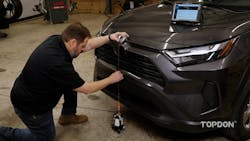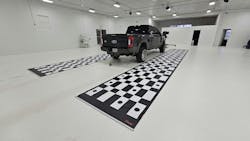Large wheel and tire fitments are continuing to grow in popularity — especially for light trucks — causing tire dealers to consider how these modifications will impact advanced driver assistance systems (ADAS).
In this exclusive, ADAS experts explain how lift kits, oversized tires and other changes can affect ADAS functionality, what dealers need to know to keep their customers’ vehicles operating safely and more.
MTD: We know the installation of plus-size tire and wheel packages on sedans can impact ADAS. Does that also apply on light trucks when large tire and wheel packages or different modifications are installed?
Josh Cascanet, field operations manager, AirPro Diagnostics: The installation of plus-size tire and wheel packages — along with other modifications, such as leveling and lift kits — demonstrably impacts the functionality of ADAS in light trucks. This effect is not limited to plus-sizing and lift kits. Lowering kits also introduce alterations that can compromise ADAS calibration and performance, mirroring the observed effects on sedans.
Chris Gutierrez, product and training academy director, Autel North America: Reading case studies and articles written by several different authors within the automotive industry, the consensus is the same. Modifying what the manufacturer has set as the stock specification will have an impact on the response and action of the designed outcome of ADAS systems. No matter the margin of error, making modifications transfers the liability and removes the original equipment manufacturer's (OEM) responsibility.
Installing large tire and wheel packages or making modifications like lift kits on light trucks can impact a vehicle's ADAS. Just like any other vehicle, light truck ADAS systems rely on cameras, radar, lidar and other sensors that are calibrated to the vehicle’s factory ride height and wheel specifications. Any changes to these factors can lead to misalignment of ADAS components, potentially affecting safety and performance.
Scott McKinney, senior product manager, Bosch Mobility Aftermarket: The installation of large tire and wheel packages in light trucks can impact the vehicle's ADAS technology and the technician's ability to recalibrate them. Many ADAS features, including lane-keeping assist and automatic emergency braking, rely on sensors that are calibrated to a vehicle's original ride height and tire size.
However, recent research has shown some really interesting conclusions, suggesting that changing a vehicle's ride height might not affect ADAS technology as much as we thought. Even so, it's important for vehicles to stay within OEM guidelines, because that's how most calibration tools are designed to work best.
Jeff Deskin, director of vehicle technology, Car ADAS Solutions: The same principle applies to trucks as it does to cars. If the sensor's installation height, angle or pitch changes due to modifications or damage, this can have detrimental effects on the ability of the sensor to see the world properly.
The sensor’s algorithm to understand the signals it sees is based on a specific mounting location on the vehicle and specific mounting angles. For example, installing a leveling kit or lift kit on a truck would change the vertical angle (pitch) of the front radar, potentially causing the radar to be looking too high or too low — causing the automatic emergency braking or forward collision warning system to not react as fast as it should.
Ryan Gerber, ADAS product specialist, Hunter Engineering Co.: Whenever a modification — even a subtle or minor modification, like replacing worn tires or suspension components — is made to ride height, service documentation must be referenced. Manufacturers will specify when calibrations are required or recommended.
Haakan Light, USA training and development manager, Topdon USA: Aftermarket modifications to the vehicle typically do not come with any information or specifications that allow you to tell the ADAS systems that there are changes to the vehicle’s geometry. That creates a problem with ADAS systems and can prevent them from functioning safely and correctly.
By contrast, there are some vehicle manufacturers who make upfit kits or factory accessories like lift kits. Toyota is an excellent example. They make a performance lift kit for the Tacoma. Those kits come with all necessary hardware to modify the vehicle, including all of the programming information you need to give to the vehicle’s ADAS systems in order for them to work correctly and safely with that lift kit. Original equipment-supplied lift kits and modifications often are going to be perfectly safe because the OEM understands how the vehicle has to be modified and they have accounted for all those things.
MTD: What are some of the effects on ADAS when installing large wheel and tire packages?
Cascanet (AirPro Diagnostics): The repercussions of installing larger wheel and tire packages on a vehicle's ADAS are multifaceted and vary depending on the specific systems, features and manufacturer. These modifications can lead to delays or failures in critical functions, including lane-keeping intervention, forward collision warning and pedestrian mitigation. Additionally, variations in blind spot and cross-traffic alert distances are common.
Industry testing — conducted under controlled conditions adhering to National Highway Traffic Safety Administration and New Car Assessment Program standards — consistently reveals changes in ADAS functionality with changes to ride height. Specifically, these tests demonstrate that systems like lane keeping assistance, forward collision warning, collision mitigation and pedestrian mitigation activate later than in a stock set-up, resulting in closer proximity to the target during activation.
Gutierrez (Autel): Camera and sensor misalignment could happen. ADAS systems such as lane departure warning, adaptive cruise control and automatic emergency braking depend on cameras and radar positioned at specific angles and heights. Changing the tire and wheel size alters the vehicle’s stance and can misalign these sensors, causing inaccurate reading.
Speedometer and odometer errors could occur because larger tires increase the rolling circumference, which can lead to incorrect speed and distance measurements. Since some ADAS functions rely on speed input, miscalculations could occur.
Many ADAS features work in conjunction with (the) electronic stability control system. So the steering and stability control could have issues because the larger tires or altered ride height can affect steering response and traction control, potentially reducing system effectiveness.
McKinney (Bosch): Changing a vehicle's height with larger tires or wheel packages can impact the accuracy and effectiveness of the sensors that ADAS technology relies on. For instance, larger tires can alter the effective gear ratio of the vehicle, which can affect the accuracy of the wheel speed sensor and impact traction control and stability control.
Deskin (Car ADAS Solutions): There have been studies by several third-party companies (about) the effect vehicle modifications have on ADAS. The results clearly showed that the higher the lift kit or the more you change the radar/camera pitch causes the sensors to not properly detect road markings and vehicles in front of it.
Gerber (Hunter): In the case of modifications, ADAS sensors will not remain in their originally intended place. Additionally, in the case of repair or service, they’ll have moved from their learned place. Both conditions will cause the sensors to be out of calibration or specification.
Light (Topdon): Large wheel and tire packages change the geometrical angles of the ADAS sensors and how they are aligned to the traffic in front of them or to the sides. It’s physically altering the three-dimensional geometry of the sensor in relation to the objects it’s attempting to detect. That means it could be compromising it.
MTD: What are some complications that could arise with ADAS when putting lift kits or large tire and wheel fitments on light trucks?
Cascanet (AirPro Diagnostics): Significant complications arise when lift kits or larger tire and wheel fitments are applied to light trucks. Notably, OEMs typically do not endorse ADAS calibrations on vehicles with altered ride heights. Aftermarket modifications that change the vehicle's ride height can impede calibration success, often resulting in persistent dashboard warning lights and messages that remain until the vehicle is returned to its stock configuration and recalibrated.
For instance, a recent observation involved a truck with a pronounced front rake, which triggered a "front camera unavailable" warning. Diagnostic scanning revealed a diagnostic trouble code for camera misalignment, as the camera angle fell outside of factory specifications. Repair facilities commonly refuse to perform ADAS calibrations on vehicles with altered ride heights and OEM procedures necessitate specific calibrations following repairs such as front-end work and alignments, further complicating matters.
Gutierrez (Autel): This could cause radar and lidar displacement. Forward-facing radar and lidar sensors used for adaptive cruise control and collision avoidance are calibrated at a precise height. Lifting a truck raises these sensors, potentially leading to miscalculations in detecting obstacles or vehicles ahead. If a truck is lifted, the angle of rear-facing radar sensors used for blind-spot detection may be altered, resulting in false positives or missed warnings.
There may be lane-keeping and lane departure warning calibration issues because the position of cameras mounted in the windshield or front grille may no longer align properly with road markings, causing these systems to function incorrectly or disengage. Or there could be an impact on suspension and ride dynamics. Modifications like lift kits change suspension geometry, affecting the way the vehicle handles and responds to inputs. ADAS systems may struggle to compensate for these differences.
McKinney (Bosch): Installing a lift kit or large tires can create a number of issues for ADAS technologies on a light vehicle. Some of the more common issues include:
- Miscalculated lane-keeping assist. If the sensors are not calibrated to the altered height of the vehicle, they may not be able to accurately detect lane markings.
- Issues with automatic emergency braking. If the automatic emergency braking system is not recalibrated after installing larger tires, it may not be able to accurately detect a potential collision.
- Adaptive cruise control problems. The adaptive cruise control system may not accurately detect a potential collision if the system isn't properly calibrated.
Deskin (Car ADAS Solutions): Any truck lifted more than two inches has typically had problems calibrating and is not recommended until returned to stock condition. It seems during calibration the sensors are looking at the signals they are seeing with more scrutiny. During calibration you can also discover other issues, such as misalignments or natural wear on the sensor.
Gerber (Hunter): We can group the complications into three high-level categories. None are ideal if not addressed:
Nothing happens. In this case, the changes are small and the sensor relearns as the customer drives the vehicle. That’s the best case. (Worst case is the) changes are large and the system is operating, but cannot validate or calibrate. The driver won’t know this until it’s too late.
Little happens. The customer may feel or notice some irregularities with the driving performance, lane keep, adaptive cruise or other ADAS systems. Again, the changes were not meeting the threshold for outright failure.
Warning light or system failure. The ADAS system is rendered inoperative and a warning light illuminates on the dash.
Light (Topdon): It has the potential to either cause the ADAS to not perform correctly or potentially not function at all. Depending on how severe the lift kit is, it may completely fail to detect objects in its path, which in turn defeats the purpose of the ADAS system in the first place.
MTD: What are some general things that tire dealers and other tire/wheel installers need to know about ride height and its effect on light truck ADAS?
Cascanet (AirPro Diagnostics): Tire dealers and wheel installers must prioritize adherence to OEM tire specifications to ensure the integrity of the vehicles ADAS operability. Modifications to tire size, speed rating, load index, traction and handling ratings can alter vehicle handling characteristics, potentially affecting ADAS operability. Consulting OEM service information is paramount before attempting any ADAS calibration.
Calibration prerequisites — including level ground, proper lighting and sufficient workspace — must be strictly followed. Under no circumstances should targets be manipulated to force a calibration. Instead, a thorough inspection for damage, misalignment or unsecured components is essential.
It is crucial to recognize that there are no OEM-approved methods for adjusting ADAS calibrations for ride height changes. Furthermore, ride height parameters are often critical for successful static calibrations, particularly for forward-facing cameras. In the event of a calibration failure, OEM service information should be consulted for updated procedures, including potential control module updates.
Gutierrez (Autel): Whenever the ride height or wheel/tire size changes, recalibrating the vehicle’s ADAS is critical. This typically requires specialized equipment and software.
Use the OEM service information for the recalibration procedures. Some OEMs provide specifications on allowable changes before ADAS recalibration is required. Exceeding these limits may cause system malfunctions.
Dealers should be aware of customer complaints and system warnings. Customers may report ADAS warnings or performance issues after modifications. Educating the end user on the implications for the modification and the need for recalibration can prevent misunderstandings.
Dealers should also avoid excessive changes without professional input. While minor modifications might not have drastic effects, extreme lifts, oversized tires or drastic wheel offsets can significantly impact safety and system functionality.
Tire and wheel modifications on light trucks can substantially affect ADAS performance. Installers must understand the impact of ride height changes, ensure proper ADAS calibrations when necessary and educate customers on potential safety concerns. Even though modifications of these ADAS systems may not appear to be significant at the time of installation, you need to understand that you are introducing variables and could be accepting responsibility of the end result and actions. Being proactive in addressing these issues can help prevent system malfunctions and liability risks.
McKinney (Bosch): Ride height is a critical factor for ADAS, as it affects the angle and field of view of the sensors. Any change in ride height, either due to tire and wheel modifications or suspension modifications, can impact the accuracy and performance of ADAS.
Technicians should consider performing a diagnostic scan after performing a recalibration to make sure the job is done properly and there are no codes or alerts associated with the ADAS technologies. ADAS recalibrations should be performed by qualified automotive technicians to ensure that the system's features operate correctly and safely.
Deskin (Car ADAS Solutions): There are a few instances of factory-approved lift kits available from Toyota and General Motors. After installing these kits, there are special methods to calibrate and or reprogram radars and cameras using the factory scan tool following a special procedure. Toyota even has a technical service bulletin regarding modified/lifted vehicles that come into the dealer without an approved lift kit. (Technicians are) instructed to disable the pre-collision system as a precaution and safety to the driver, as the system will not behave as it was designed to due to the modifications. This shows that modifications such as oversized tires and lift kits can affect ADAS sensors and there is some amount of liability in modifying a vehicle with ADAS without using factory-approved lift kits/ with factory-approved ADAS calibration methods, so all the vehicles ADAS features function as designed.
Gerber (Hunter): Ride height plays a critical role in properly functioning ADAS technology. Workshops can address situations with some easy-to-access information and tools. Many service information providers have reference guides for ADAS, making the path to find when to service and what to service very clear. Many scan tools, like Hunter’s ADASLink, have built-in capabilities to address dynamic (driving) calibrations.
There are also resources available from organizations like SEMA that help provide guidance for modification outside of the service and repair arena. The best part is that ADAS provides another path for revenue through the needed services, and the customer is provided a properly repaired or modified vehicle!
Light (Topdon): There are potential liability issues. At this point in time, it’s best recommended to decline servicing the ADAS systems on vehicles with aftermarket lift kits and oversize wheels and tires. A shop can say., “We are unable to provide service on this vehicle because it has been modified away from the factory configuration and we cannot attest that this vehicle can be operated with the ADAS systems intact and safely performing as a result of these modifications.” It’s not advisable to perform ADAS calibrations on aftermarket modified vehicles.
About the Author
Madison Hartline
Associate Editor
Madison Hartline (Gehring) is the associate editor for Modern Tire Dealer and Motor Age. Since joining MTD after graduating from The Ohio State University in 2022, she has taken on the role of managing the brand’s social media strategy, producing podcast episodes and overseeing eNewsletter content.
Don't miss Hartline's next article. Sign up for MTD's newsletter.



